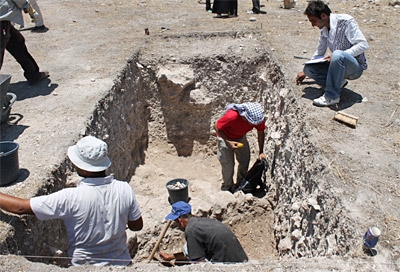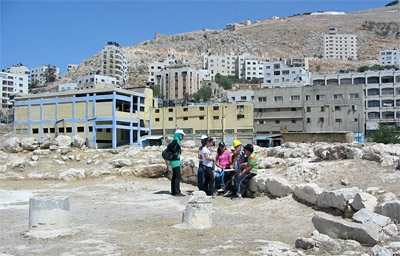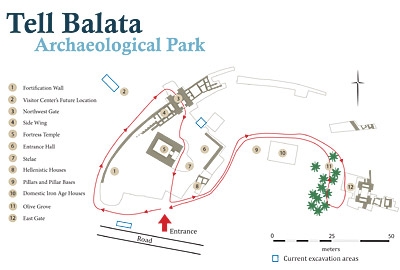2011 Tell Balata Campaign 2011
The objectives of the 2011 campaign Tell Balata Archaeological Park are to carry out excavations, promotion and awareness, community involvement, gathering oral histories and educating children. The objectives are described in a handout produced for the opening ceremony on June 21st 2011.

Fieldwork was carried out for a period of 6 weeks (11 June – 21 July 2011). The Joint Palestinian – Dutch field activities involved excavations on the one hand, and elements of site management, such as emergency and conservation actions, and especially activities concerning community archaeology, on the other hand.
Tasks
Archaeological research and excavations are necessary in order to know and understand the history of use of the site. Much work was done towards this goal by large-scale German and American excavations during the early and middle 20th century, but the results of this work have to be assessed in order to make available up-to-date information and interpretation for the public. Practically speaking, in the field this means making clear what has been unearthed, refilled, washed in and crumbled down in subsequent years.

Schoolchildren visiting the site
Last year clearance as well as removal of dumped material was carried out. This year’s fieldwork will include removal of more dumped material in selected areas, as well as additional excavations in some selected places. The aim is to clarify unclear results from previous excavations and acquire additional data, such as those dealing with chronology. Some excavations explore new spots to answer specific questions. The fieldwork also concerns additional surveying and mapping.
Excavations
The locations for excavations are chosen based upon surface-information, questions raised by assessing previous excavations, and preliminary priorities for further research, in connection with the site management policy.
Within the site management tasks fieldwork extends beyond the two months. It concerns additional clearance of excavated parts and structures, especially removal of washed-in soil and stones, at several places, but the selection depends on their value as element of the heritage of the site. In addition emergency work and consolidation or restoration of exposed remains and vulnerable parts will take place – also going beyond two months.

- A Test trench west of the western city wall with 5 squares in row – 2m wide parts are excavated first; the goal is to explore the archaeological situation at the spot to be used for the visitor’s centre.
- A 10x10m area east of the NW-gate, below the German excavations and bordering a deep American trench; the goal is to explore architecture on the surface and get a stratigraphic sequence down to the lower MB-LB structures.
- An exploration trench at the western edge of the site, near the section that was cut for road some years ago two squares in a row, close to that section The goal is to understand the walls and debris visible in the road-cut and get a view of this unexplored part of the site.
- Additional small scale excavations are planned in three other areas:
- Alongside the old German trench to explore the stratigraphic position of the heavily burnt wall debris found there.
- In the centre of the site, bordering the deeply excavated American field in order to explore the Hellenistic and Iron II layers, and add chronological data such as carbon-14 dates.
- At the eastern gate, some excavations at the northern edge, setting back the old section, are needed to explore the stratigraphic connection between Middle Bronze, Late Bronze and Hellenistic strata in this area.
